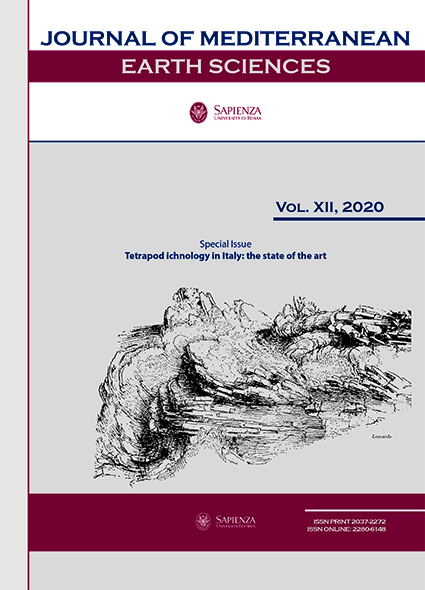The Early Permian tetrapod ichnoassociation from Italy
DOI:
https://doi.org/10.3304/jmes.2020.17064Keywords:
geologyAbstract
The Early Permian tetrapod ichnoassociation from Italy is long known, in fact it is the first described from this area. After some pioneering works in the 19th century, several new works and discoveries were done starting from the second half of the 20th century until nowadays. The Early Permian tetrapod ichnoassociation from Italy is characterized by abundant and diverse reptile tracks (Dromopus, Erpetopus, Hylodichnus, Merifontichnus and Varanopus), uncommon anamniote tracks (Amphisauropus, Batrachichnus and Limnopus) and very rare synpsid tracks (cf. Dimetropus). The bulk of discoveries is located in the central Southern Alps, in the Orobic and Collio basins, and in minor part in the Athesian District. These basins include a well-preserved and diverse ichnoassociation that is central in tetrapod footprint biostratigraphy and in the definition of the late Cisuralian reptile radiation inferred from the footprint record, well calibrated by several and recent radiometric dates that constrained the age of the footprint-bearing units. The new findings from NW Sardinia include to-date a smaller late Kungurian?-Roadian ichnoassociation, that however deserves great attention because of the possible biostratigraphic implications and the unusual co-occurrence with tetrapod remainsDownloads
Published
2020-09-22
How to Cite
Santi, G., Marchetti, L., Schirolli, P., & Ronchi, A. (2020). The Early Permian tetrapod ichnoassociation from Italy. Journal of Mediterranean Earth Sciences, 12. https://doi.org/10.3304/jmes.2020.17064
Issue
Section
Tetrapod ichnology in Italy: the state of the art
License
The submission has not been previously published, nor is it before another journal for consideration (or an explanation has been provided in Comments to the Editor).


